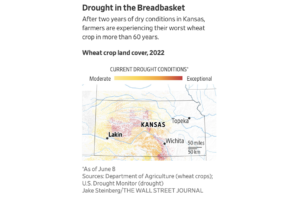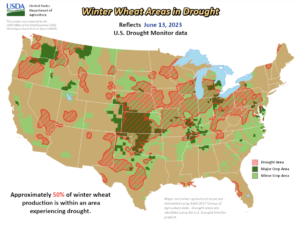Agriculture leaders in the United States House of Representatives are looking to provide at least an additional $10 billion in farmer aid to supplement the recently announced Farmer Bridge Assistance…
Expected Record U.S. Corn, Soybean Production “In Jeopardy Due to Problematic Weather”
Wall Street Journal writer Shannon Najmabadi reported on Saturday that, “Were this a normal mid-June morning, farmer Gary Millershaski would be looking out at waist-high fields of golden wheat almost ready to be harvested.
“Instead, he’s standing on a patch of mud, plucking at thin stalks of wheat that poke less than a foot out of the ground.
It is the result of a multiyear drought that has left farmers in the country’s breadbasket with likely their worst wheat crop in more than 60 years.
The Journal article explained that, “Around a third of the winter wheat grown nationwide is expected to be abandoned because it is uneconomical to harvest it this year. It is the highest rate of abandonment since 1917, exceeding the rate of wheat abandoned during the 1930s Dust Bowl.
“There is enough winter wheat for domestic consumption but volatile world market conditions have motivated U.S. mills to import wheat for flour, and the hit to U.S. farmers is acute.
“Abandoned fields will be left out for cattle to graze on, slashed and used as hay or killed with chemicals so farmers can collect on crop insurance and get new seeds into the ground.”

Najmabadi pointed out that, “Other Plains states like Oklahoma and Texas are expected to abandon wheat at even higher rates than Kansas.
“Kansas is the top winter-wheat producing state in the country. The U.S. is among the top five global exporters of wheat.”

“Recent downpours have helped revive some wilting wheat fields, particularly in the northwest part of the state, and offered hope that milo, corn and other crops being planted now will flourish.
“But for many places, the May and June rain is too late.”

Recall, however, that global wheat production is currently forecast at a record high level.
Dow Jones writer Yusuf Khan reported on Friday that, “Prices for wheat and corn have ticked higher over the last week since the explosion of the Kakhovka dam in Ukraine, however ample supplies and forecasts of record crops in the coming year are likely to keep prices in check, analysts say.”
Nonetheless, Kirk Maltais reported on Friday at The Wall Street Journal Online that, “Growing drought conditions across the U.S. Corn Belt this summer could take a bite out of what was expected to be a strong crop of corn, wheat and soybeans.”
Grains: Mounting concerns over dry weather and the possibility that Russia may withdraw from the deal that allows #Ukraine to safely ship grain from #BlackSea ports will add to volatility in the market.https://t.co/EtCtcuZOth pic.twitter.com/yfBxjZAhhH
— FarmPolicy (@FarmPolicy) June 19, 2023
Also on Friday, Reuters writer Julie Ingwersen reported that,
U.S. corn, soybean and wheat futures all set multi-month highs on Friday as worries about stressful dry conditions in key portions of the Midwest prompted a flurry of buying ahead of a three-day holiday weekend, analysts said.
“The U.S. Department of Agriculture in May projected record-large U.S. corn and soybean harvests for 2023, but those targets are in jeopardy due to problematic weather as the summer growing season unfolds.”
In other news, Bloomberg writer Hallie Gu reported today that, “China is bracing for more extreme weather in coming days, bringing further risks to grain production across the nation.
“While high temperatures in northern areas could affect corn planting and harm wheat crops, heavy rains are likely to hurt rice in key southern growing regions, according to a report from the National Meteorological Center.”
And Reuters writer Dominique Patton reported today that, “China’s soybean imports from Brazil soared 40% in May, compared with a year-ago period, data showed on Tuesday, after big purchases of cheap beans arrived into Chinese ports.
“The world’s top buyer of soybeans imported 10.94 million metric tons of the oilseed from Brazil, its largest supplier, versus 7.79 million tons a year earlier, data from the General Administration of Customs showed.”





